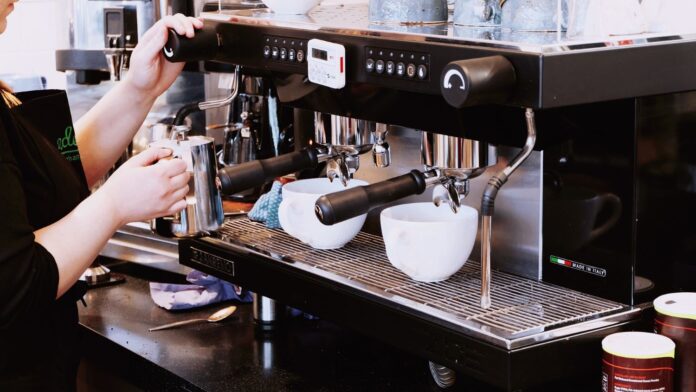Do you know that cleaning your Cuisinart Coffee maker regularly can help the device’s longevity?
For coffee lovers, a good coffee maker is an essential kitchen appliance. Cuisinart, one of the leading brands in the coffee maker industry, has been providing quality and convenience to coffee enthusiasts for years.
However, like any other appliance, a Cuisinart coffee maker also requires regular cleaning and maintenance to ensure optimum performance.
In this guide, we will take you through step-by-step instructions on how to clean your Cuisinart coffee maker – from removing the built-up coffee grinds and mineral deposits to maintaining its parts and accessories.
Not only will regular cleaning help your coffee maker last longer, but it will also ensure that your coffee is fresh and delicious every time you brew it.
So, let’s dive into the ultimate guide to cleaning your Cuisinart coffee maker!
An Overview Of The Cuisinart Coffee Maker
The Cuisinart coffee maker is a beloved appliance in many households, known for its sleek design, ease of use, and ability to brew a delicious cup of coffee.
Whether you’re a coffee aficionado or just enjoy a morning pick-me-up, this guide will take you through the ins and outs of cleaning your Cuisinart coffee maker. It will also ensure that it continues to produce the best-tasting coffee every time.
Introduced to the market with innovative features and cutting-edge technology, the Cuisinart coffee maker has become a staple in kitchens around the world.
Its sleek and modern design adds a touch of elegance to any countertop, while its user-friendly interface makes it a breeze to operate.
But like any other kitchen appliance, proper maintenance, and regular cleaning are essential to keep your Cuisinart coffee maker running at its best.
Over time, mineral deposits, coffee oils, and other impurities can build up inside the machine, affecting the taste and quality of your coffee.
That’s why it’s crucial to familiarize yourself with the cleaning process and incorporate it into your routine.
In this comprehensive guide, we will walk you through the step-by-step process of cleaning your Cuisinart coffee maker, from the exterior to the internal components.
Whether you’re a first-time owner or a seasoned coffee enthusiast, following these cleaning tips will not only prolong the lifespan of your machine but also ensure that each cup of coffee is brewed to perfection.
So, grab your favorite mug, sit back, and get ready to learn how to keep your Cuisinart coffee maker in pristine condition. Hence, allowing you to enjoy the rich aromas and flavors of your favorite coffee blends every single day.
Let’s dive in!
Why Do You Need To Clean Your Coffee Maker Regularly?
Regular cleaning is crucial for maintaining the optimal performance and longevity of your Cuisinart coffee maker.
Over time, coffee residue, oils, and mineral deposits can accumulate inside the machine, affecting the taste and quality of your brewed coffee.
Neglecting to clean your coffee maker can result in a buildup of these contaminants, leading to clogged or slow-flowing water, a decrease in brewing temperature, and even potential bacterial growth.
Not only does regular cleaning enhance the flavor and aroma of your coffee, but it also ensures that your machine operates efficiently.
When the internal components are free from buildup, water can flow smoothly, allowing for proper extraction of the coffee grounds and optimal brewing conditions.
This results in a rich, flavorful cup of coffee every time.
Moreover, cleaning your coffee maker helps to prevent the transfer of flavors and odors from previous brews, ensuring that each cup tastes fresh and delicious.
When oils and residue accumulate, they can impart a stale or bitter taste to your coffee, diminishing the overall experience.
In addition to taste and performance, regular cleaning also helps to maintain the hygiene and safety of your coffee maker.
Moisture and warmth create an ideal environment for bacteria and mold to thrive.
By regularly cleaning and sanitizing your machine, you minimize the risk of these harmful microorganisms contaminating your coffee and potentially causing health issues.
Preparing Your Coffee Maker For Cleaning
Before diving into the cleaning process, it’s crucial to properly prepare your Cuisinart coffee maker. By taking a few simple steps, you can ensure a more effective and efficient cleaning experience.
Firstly, make sure your coffee maker is unplugged from the power source to avoid any accidents during the cleaning process. Safety should always be a top priority.
Next, remove any remaining coffee grounds or used filters from the machine. Emptying the coffee grounds and discarding the filter will prevent any debris from interfering with the cleaning process.
For coffee makers with removable parts, such as the filter basket or carafe, detach them from the machine. These components are often dishwasher-safe, so you can save time by placing them in the dishwasher for a thorough clean.
However, be sure to check the manufacturer’s instructions to ensure the parts are dishwasher-safe.
If your coffee maker doesn’t have removable parts, you can still clean the exterior and interior by wiping them down with a damp cloth.
Pay special attention to any areas that may have accumulated coffee stains or residue.
Lastly, if your coffee maker has a water reservoir, empty any remaining water from it. This step is essential as it allows you to start the cleaning process with a fresh slate.
By preparing your coffee maker for cleaning, you set the stage for a successful and thorough cleaning session.
Taking the time to properly prepare your machine ensures that you’ll be able to enjoy a delicious cup of coffee from a clean and well-maintained Cuisinart coffee maker.
Step-By-Step Guide To Cleaning The Cuisinart Coffee Maker

Cleaning your Cuisinart Coffee Maker is essential for ensuring that you continue to enjoy the best-tasting coffee every morning.
Here is a step-by-step guide to help you clean your Cuisinart Coffee Maker effectively:
Step 1: Preparation
Start by gathering all the necessary supplies. You will need white vinegar, water, a clean sponge or cloth, and a toothbrush or small brush for hard-to-reach areas.
Step 2: Empty And Rinse
First, make sure that your coffee maker is turned off and unplugged. Remove any remaining coffee grounds or filters from the machine. Dispose of them appropriately. Then, give the carafe a thorough rinse with warm soapy water.
Step 3: Vinegar Solution
Prepare a mixture of equal parts white vinegar and water. For example, if you are using 1 cup of water, mix it with 1 cup of vinegar. This solution will effectively remove mineral deposits and buildup inside the coffee maker.
Step 4: Run The Cleaning Cycle
Fill the water reservoir of your Cuisinart Coffee Maker with the vinegar solution. Place an empty coffee filter in the brew basket.
Turn on the coffee maker and let it run through a complete brewing cycle. The vinegar solution will clean the inner components and remove any lingering residue.
Step 5: Rinse And Repeat
Once the cleaning cycle is complete, discard the vinegar solution and replace it with clean water. Run another brewing cycle with just water to rinse out any remaining vinegar taste or odor.
Step 6: Clean the Exterior
While the machine is still unplugged, use a damp sponge or cloth to wipe down the exterior surfaces of the coffee maker. Pay extra attention to any areas that may have accumulated coffee stains or spills.
For stubborn stains, use a mild dish soap and a toothbrush or small brush to gently scrub the affected area.
Step 7: Final Rinse
Empty the water reservoir once again and refill it with clean water. Run a final brewing cycle with just water to ensure that any cleaning solution or residue is completely flushed out.
Step 8: Regular Maintenance
To keep your Cuisinart Coffee Maker in pristine condition, it’s recommended to clean the removable parts, such as the carafe and brew basket, after every use.
Additionally, descaling the coffee maker with vinegar solution every few months will prevent mineral buildup and maintain optimal performance.
Following these simple steps, you can easily clean your Cuisinart Coffee Maker and enjoy fresh, flavorful coffee for a long time to come.
Remember, regular maintenance will not only extend the life of your coffee maker but also ensure that each cup you brew is as delicious as the last.
Maintenance Tips For Cleaning Your Coffee Maker
Maintaining a clean coffee maker is essential for ensuring the longevity and optimal performance of your Cuisinart coffee maker.
Here are some tips and tricks to help you keep your coffee maker in pristine condition.
1. Regularly clean the removable parts: Start by removing the carafe, filter basket, and any other detachable components. These parts should be washed with warm, soapy water after each use to remove any coffee residue or oils that may have accumulated.
2. Descale your coffee maker: Over time, mineral deposits from water can build up inside your coffee maker, affecting the taste of your coffee and potentially clogging the machine.
Descaling removes these deposits and helps to maintain the efficiency of your coffee maker. Follow the manufacturer’s instructions for descaling, using either a commercial descaling solution or a mixture of vinegar and water.
3. Clean the exterior: Don’t forget to clean the exterior of your coffee maker, as dirt and fingerprints can accumulate over time. Use a damp cloth or sponge with mild detergent to gently wipe down the exterior surfaces.
Avoid using abrasive cleaners or scrub brushes that could damage the finish.
4. Pay attention to the brew basket: The brew basket is where the coffee grounds are placed. After each use, rinse it thoroughly to remove any leftover grounds.
If the brew basket becomes clogged with coffee residue, soak it in warm, soapy water and gently scrub it with a brush to dislodge any buildup.
5. Run a cleaning cycle: Some Cuisinart coffee makers have a self-cleaning function. If your model has this feature, follow the instructions in the user manual to run a cleaning cycle.
This will help remove any accumulated residue from the internal components of the machine.
Troubleshooting Common Issues With The Cuisinart Coffee Maker
Even the best coffee makers can encounter issues from time to time, and the Cuisinart Coffee Maker is no exception.
However, troubleshooting common problems can help you get your machine back up and running in no time.
The coffee tastes off.
If your coffee tastes strange or has an unusual flavor, it could be due to mineral buildup or residue in the machine. To fix this, start by descaling the coffee maker using a mixture of equal parts water and vinegar. Run this solution through the machine, followed by a few cycles of plain water to rinse out any remaining vinegar taste.
Slow brewing
If your coffee maker is taking longer than usual to brew a pot of coffee, it could be a sign of clogging or blockage. To fix this, try cleaning the water reservoir and filter basket thoroughly.
Remove any coffee grounds or debris that may be obstructing the flow of water. Additionally, check the water level and ensure it is filled to the appropriate mark.
Leaking water
If you notice water leaking from your Cuisinart Coffee Maker, it’s essential to identify the source of the leak.
Check the water reservoir, the brew basket, and the carafe for any cracks, loose parts, or improper positioning.
Tighten any loose components or replace any damaged parts to prevent further leakage.
The machine not turning on
If your coffee maker refuses to turn on, it could be due to a power issue or a faulty electrical connection.
First, check if the machine is properly plugged into a functioning outlet.
If it is, try resetting the circuit breaker or testing the outlet with another device to ensure it is working correctly.
Error messages or malfunctions
Some Cuisinart Coffee Makers come equipped with advanced features and digital displays that may show error messages or experience malfunctions.
In such cases, consulting the user manual specific to your model can provide valuable insights into troubleshooting steps or contacting customer support for assistance.
Remember, it’s always a good idea to refer to your Cuisinart Coffee Maker’s user manual for model-specific troubleshooting tips and guidelines. By addressing common issues promptly and following proper maintenance, you can keep your coffee maker running smoothly and enjoy a delicious cup of coffee every morning.
How Often Should You Clean Your Coffee Maker?
Regular cleaning of your Cuisinart coffee maker is essential to maintain its optimal performance and ensure that you consistently enjoy the perfect cup of coffee.
But how often should you clean it?
The frequency of cleaning your coffee maker depends on several factors, including the frequency of use and the water quality in your area.
As a general rule of thumb, it is recommended to clean your coffee maker at least once a month.
However, if you use it daily or live in an area with hard water, more frequent cleaning may be necessary.
Hard water contains minerals that can build up inside your coffee maker over time, affecting the taste of your coffee and potentially clogging the machine.
If you notice any signs of mineral buildup, such as a slower brewing time or unusual noises, it’s a good indicator that it’s time for a thorough cleaning.
Additionally, if you use your coffee maker to brew other beverages like tea or hot chocolate, cleaning it more often is advisable to prevent flavor transfer and ensure the purity of each drink.
Remember, the cleanliness of your coffee maker directly affects the quality of your coffee.
By establishing a regular cleaning routine, you’ll not only extend the lifespan of your Cuisinart coffee maker.
Besides, it also guarantees a consistently flavorful and satisfying coffee experience every time you brew.
Other Cleaning Methods And Products To Consider
As mentioned earlier, the basic cleaning methods are effective for the regular maintenance of your Cuisinart coffee maker.
However, there are other cleaning methods and products you can consider to ensure a thorough and deep clean.
These include:
Using Vinegar: Vinegar is a natural and affordable cleaning agent that can effectively remove mineral deposits and buildup in your coffee maker.
To clean with vinegar, mix equal parts of vinegar and water and pour the mixture into the water reservoir.
Run a brew cycle without any coffee grounds, and then repeat the process with clean water to rinse out any vinegar residue.
Using Citric Acid: Citric acid is a powerful natural cleaner that can help remove stubborn stains and scale from your coffee maker.
Dissolve a tablespoon of citric acid in a cup of hot water and pour it into the water reservoir.
Run a brew cycle without coffee grounds, and then repeat the process with clean water to rinse thoroughly.
Using Descaling Solutions Periodically: Descaling solutions are designed to remove mineral deposits and limescale buildup that can affect the performance and taste of your coffee.
Follow the instructions provided with the descaling solution to effectively clean your coffee maker.
Remember to always refer to your Cuisinart coffee maker’s instruction manual for any specific cleaning recommendations or precautions.
Final Thoughts And Recommendations For A Sparkling Clean Coffee Maker
Keeping your Cuisinart coffee maker clean is essential for ensuring a fresh and flavorful cup of coffee every time.
Now that you’ve learned the step-by-step process to clean your coffee maker, it’s time for some final thoughts and recommendations to maintain a sparkling clean machine.
First and foremost, it’s crucial to regularly clean your coffee maker to prevent any build-up of mineral deposits, coffee oils, or bacteria.
This will not only enhance the taste of your coffee but also prolong the lifespan of your machine.
To maintain a sparkling clean coffee maker, here are a few additional tips:
- Clean the exterior: Wipe down the exterior of your coffee maker with a damp cloth regularly to remove any stains or spills. This will not only keep your machine looking pristine but also prevent any dirt or grime from finding its way into your coffee.
- Use filtered water: Using filtered water in your coffee maker can minimize mineral build-up and keep your machine cleaner for longer. This simple adjustment can make a significant difference in the overall cleanliness of your coffee maker.
- Descale regularly: Even with regular cleaning, mineral deposits can accumulate over time. To combat this, it’s recommended to descale your coffee maker every 3-6 months, depending on the water hardness in your area. This will help remove any mineral build-up and ensure optimal performance.
- Replace worn-out parts: If you notice any worn-out or damaged parts in your Cuisinart coffee maker, such as the filter or carafe, it’s essential to replace them promptly. Using old or damaged parts can compromise the cleanliness and functionality of your machine.
We hope you found our ultimate guide on how to clean your Cuisinart coffee maker helpful.
Following the step-by-step instructions provided in this article, you’ll be able to keep your Cuisinart coffee maker clean and in optimal working condition.
Say goodbye to coffee stains and residue, and say hello to a fresh and delicious cup of coffee every morning.
We hope you enjoy the cleaning process and savor every sip of your perfectly brewed coffee!
Further Reading And References
5 Best Bacon Frying Pans: Easy To Use
The Best Apartment Size Refrigerators
5 Best Blender For Frozen Strawberries




